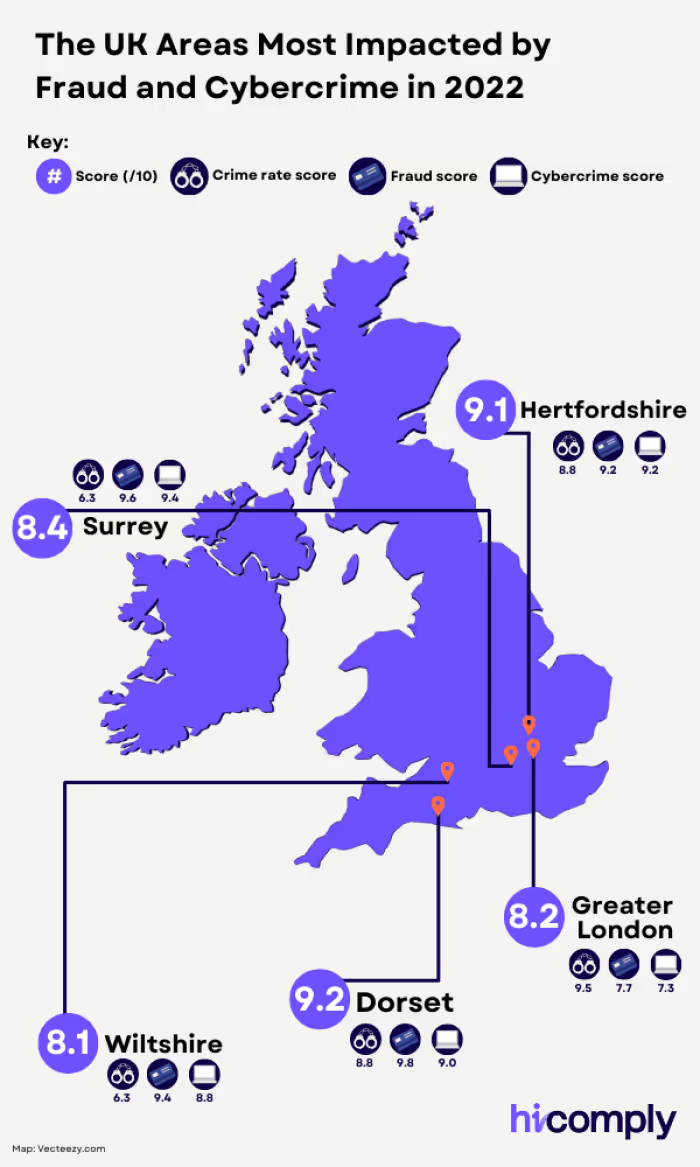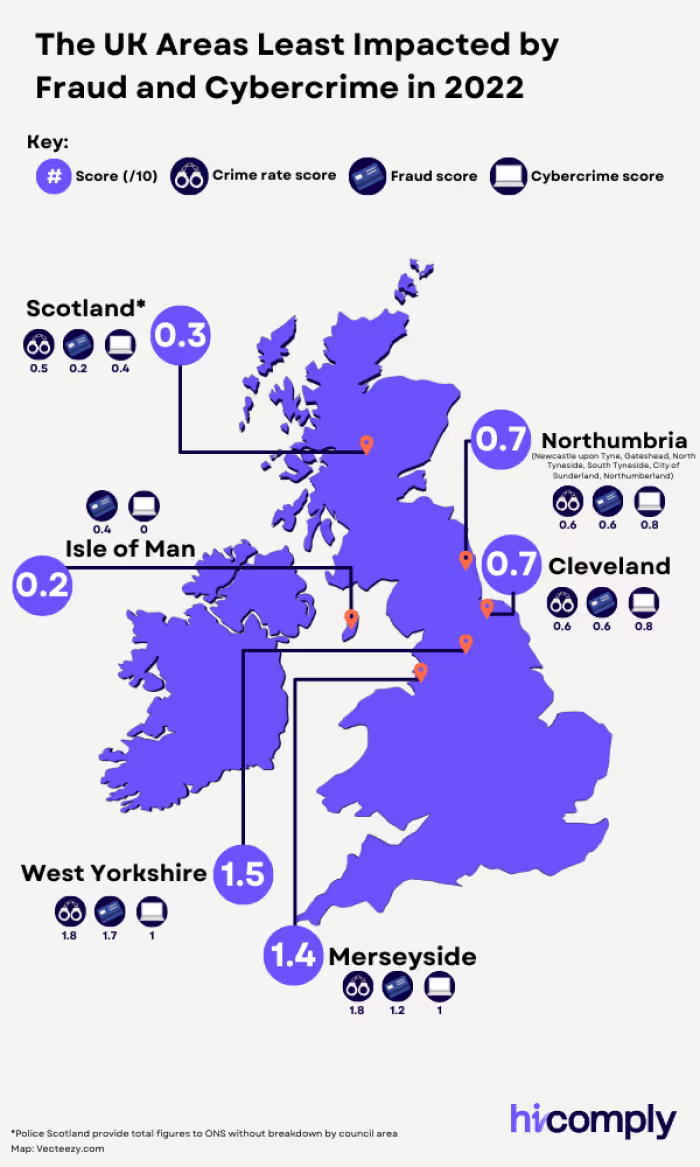Data has revealed the UK counties most impacted by fraud and cybercrime.
Using crime figures provided by regional police forces; experts at information security firm Hicomply found that 178;689 total fraud and computer misuse crimes were reported between January 1st and June 30th 2022. UK residents lost a reported £1.7billion.
Of those; 16;148 (9%) reports were classified as cyber-dependent crime; which encompasses social media and email hacking; server hacking; personal hacking; computer viruses; malware; spyware and more.
Experts looked at:
- The number of fraud and computer misuse offences; including cybercrime; recorded by police forces
- The fraud and computer misuse offence rate per 1;000 population
- The number of cybercrime offences
- Total offences recorded by regional police forces
- The percentage of fraud and computer misuse offences per total recorded offences.
- The percentage of cybercrimes per total recorded offences.
To find the areas most impacted. View the infographics below or read on to discover the areas most and least impacted by fraud and cybercrime in 2022.
Which areas had the most prolific fraud and cybercrime?

Using the data gathered from the ONS report and the NFIB Fraud and Cyber Crime dashboard; we calculated each area's fraud and cyber crime score based on: the percentage of fraud offences vs total offences in the area; the percentage of cybercrime offences vs total offences in the area; the fraud and computer misuse incident rate per 1;000 population; scoring areas out of 10. The top 5 areas were:
- Dorset (9.2/10)
- Hertfordshire (9.1/10)
- Surrey (8.4/10)
- Greater London (8.2/10)
- Wiltshire (8.1/10)
Which areas had the least prolific fraud and cybercrime?

The areas with the lowest scores included:
- Isle of Man (0.2/10 - with zero cybercrime reports in 2022)
- Scotland (0.3/10)*
- The regions covered by Northumbria Police; and Cleveland (both 0.7/10)
- Merseyside (1.4/10)
- West Yorkshire (1.4/10).
*Police Scotland provides total figures in ONS reports without breaking down by council area.
Which areas saw the most fraud and computer misuse offences?
In police data; cybercrime offences fit within the fraud and computer misuse category. Hicomply looked at areas with the highest percentage of fraud and computer misuse reports vs total crime reports; revealing that the category made up just over 10% of reports in Dorset.
Surrey and Wiltshire weren’t far behind; with fraud and computer misuse making up 9.3% of overall reports. They were followed by Hertfordshire and Dwyfed-Powys Police (which covers Carmarthenshire; Ceredigion; Pembrokeshire; and Powys) with 8.8% and 8.7% respectively. North Yorkshire; Thames Valley; Devon & Cornwall; Staffordshire; and Sussex rounded out the top ten.
Regions with highest percentage of fraud and computer misuse offences
Numbers showed; unsurprisingly; that Greater London had the highest number of fraud and computer misuse reports overall; at 32;800. The region was followed by the West Midlands at 7;000; Thames Valley at 6;900; Greater Manchester at 6;200 and West Yorkshire at 5;800.
Regions with the most fraud and computer misuse reports
Guernsey saw the lowest number of reports; with only 31.
Data also revealed areas with the highest fraud and computer misuse offences per 1000 population. Unexpectedly; Dwyfed-Powys Police saw the highest rate here; with 8 incidents per 1000 population.
Which regions saw the lowest levels of fraud and computer misuse offences?
Scotland saw the lowest percentage of fraud and computer misuse offences as a region; with only 1.55% of reported offences falling into this category; followed by the Isle of Man; Cleveland; Guernsey; Greater Manchester; Merseyside; Northumbria; West Yorkshire; West Midlands; and South Yorkshire.
Areas with smaller populations like Guernsey; which has a population of 63;463; and the Isle of Man; which has a population of 85;973; also naturally saw fewer fraud and computer misuse offences reported and these reports made up a low proportion of overall crime; at 2.69% and 2.92% respectively.
Which areas saw the highest levels of cybercrime?
For cyber-specific crimes; Surrey came out top of the list; with 0.93% of all reported offences being cybercrime incidents. The region saw 358 cybercrime incidents and 3600 fraud and computer misuse offences overall.
The list of top five most impacted areas was rounded out by Hertfordshire; Dorset; Wiltshire; and Sussex.
Regions with the highest percentage of cybercrime
Interestingly; the four regions with the highest levels of fraud reports also saw the highest levels of cybercrime:
Regions with highest percentages of fraud and cybercrime reports
Meanwhile; the Isle of Man saw zero cybercrime incidents; and Scotland saw only 0.06%: with 131 cybercrime incidents and 3600 fraud and computer misuse offences. This was followed by Jersey; Cleveland; and Northern Ireland.
Regions with the lowest levels of cybercrime
What types of cybercrime were most common?
According to data from the NFIB Fraud and Cyber Crime Dashboard; the top five cybercrime codes were:
- 8;600 reports of hacking (social media and email)
- 3;100 reports of computer virus/malware/spyware
- 2;700 reports of hacking (personal)
- 1;800 reports of hacking (extortion)
- 112 reports of hacking (server)
Which areas had the most cybercrimes reported?
London saw the highest number of cybercrime reports overall; with 2;900 reports between January and June 2022. There were 2;000 fewer reports in the West Midlands; which came in second at 704; followed by Greater Manchester; Thames Valley; and Hampshire.
Which areas had the fewest cybercrimes reported?
The Isle of Man saw zero cybercrime offences in the first half of 2022; and 1527 total reported offences.
Next to follow was Jersey; with three cybercrime reports; Guernsey with four; then Cleveland with 102 and Cumbria with 112. Find the 10 police forces that recorded the fewest cybercrimes below:
How does 2022 compare to previous years?
Data shows that between April 2021 and March 2022; reported incidents of fraud and computer misuse actually decreased in every region in England and Wales compared to the previous year. The region with the biggest change from the previous year was Somerset & Avon; which saw an 81% decrease in reports; followed by Greater London (-33%); Gloucestershire (-23%); Warwickshire (-23%); and North Yorkshire (-23%).
Change in reported fraud and computer misuse incidents YoY
*Data from PSNI was not included when reviewing data for this table. PSNI groups fraud and computer misuse incidents within online crime; which includes crimes outside of the scope of this report.
This drastic difference in reports of fraud and computer misuse between early 2021 and 2022 may be in part due to the COVID-19 pandemic.
In July 2020; Action Fraud reported that a total of £11;316;266 had been reported lost by 2;866 victims of coronavirus-related scams. The organisation received 13;820 reports of coronavirus-related phishing emails; and it also shared that the majority of reports received were related to online shopping scams where victims ordered protective products such as face masks and hand sanitiser; which never arrived.
How can we prevent cybercrime?
Marius van Aswegen; Chief Operations Officer at Hicomply; said: “One of the most obvious ways we can stop successful cybercrime attempts is by recognising the signs of an attack. The data shows that hacking is one of the most common cybercrimes we face in the UK.
“Phishing; which is a method of tricking the target into revealing sensitive or personal information; is one method cybercriminals use to maliciously gain access to data. Make sure to learn the signs to look out for so you can identify fake emails and text messages. For organisations; it’s important to invest in regular staff training and awareness.”
Signs a message or email may not be legitimate include:
- The message comes from email address or mobile number that doesn’t match that of the real sender. E.g. A Gmail address is used to send you an email about your bank account
- The message includes spelling or grammatical errors
- There is an urgent call to action with ‘serious’ consequences if you don’t act immediately
- You are asked to click on a link that doesn’t match the domain of the real organisation or sender.
Think you could recognise fraudulent activity? Put your knowledge to the test in our quiz: Can You Spot a Scam?
Sources –
- NFIB Fraud and Cyber Crime Dashboard https://colp.maps.arcgis.com/apps/dashboards/0334150e430449cf8ac917e347897d46
- ONS https://www.ons.gov.uk/peoplepopulationandcommunity/crimeandjustice/datasets/policeforceareadatatables
- PSNI data extrapolated from 2021-2022 for Jan-June 2022 https://www.psni.police.uk/globalassets/inside-the-psni/our-statistics/police-recorded-crime-statistics/2022/march/crime-bulletin-mar-_22.pdf
- Data estimated from Jersey Police 2021 report https://jersey.police.uk/accessing-information/force-publications/annual-statistics/
- Data from Police Scotland 2021-2022 extrapolated for Jan-June 2022 https://www.gov.scot/publications/recorded-crime-scotland-2021-2022/pages/17/
- Fraud data for Scotland https://www.gov.scot/publications/recorded-crime-scotland-2021-2022/documents/
- Overall offences data from Isle of Man Constabulary estimated from 2020-2021 statistics https://www.iompolice.im/media/1403/all-charts-and-tables-2020-2021.pdf





.svg)





